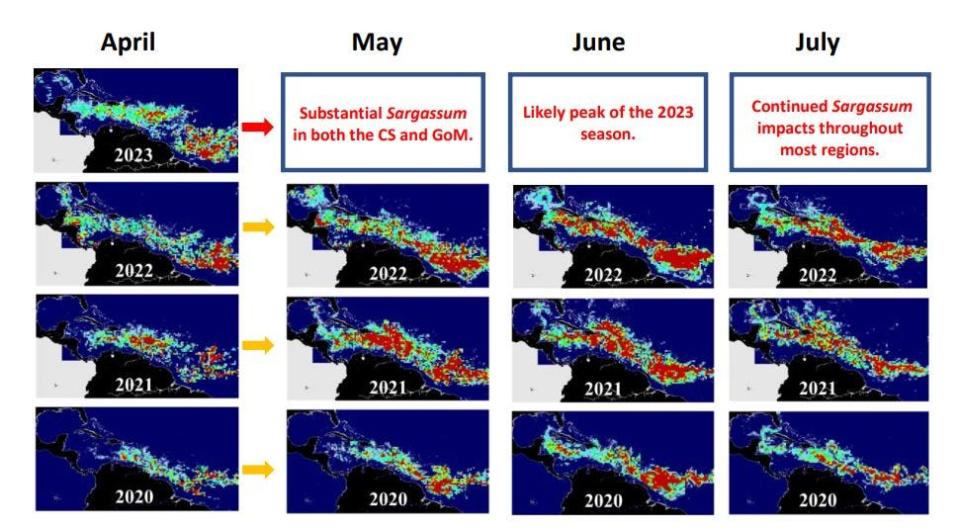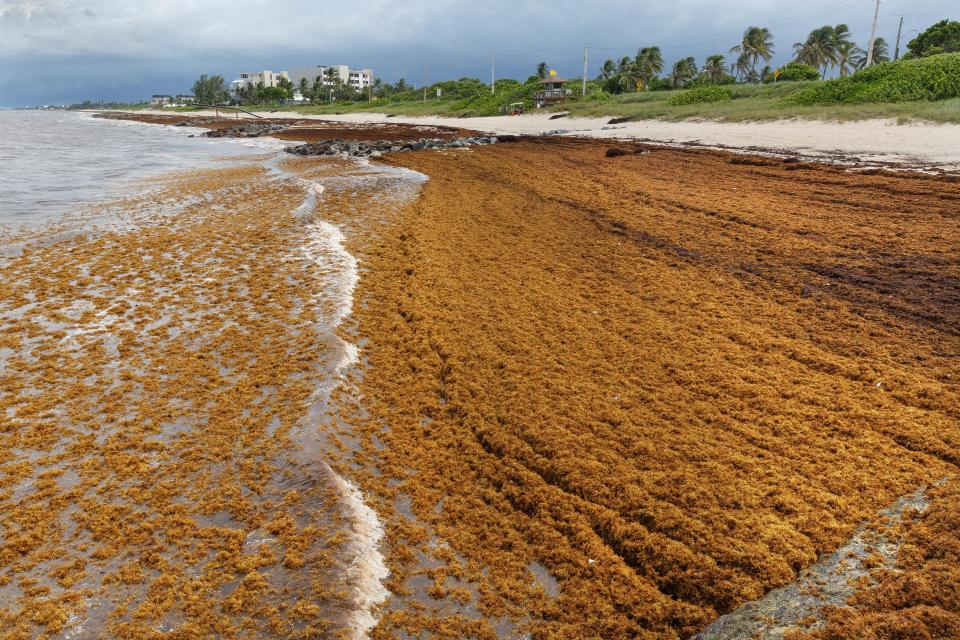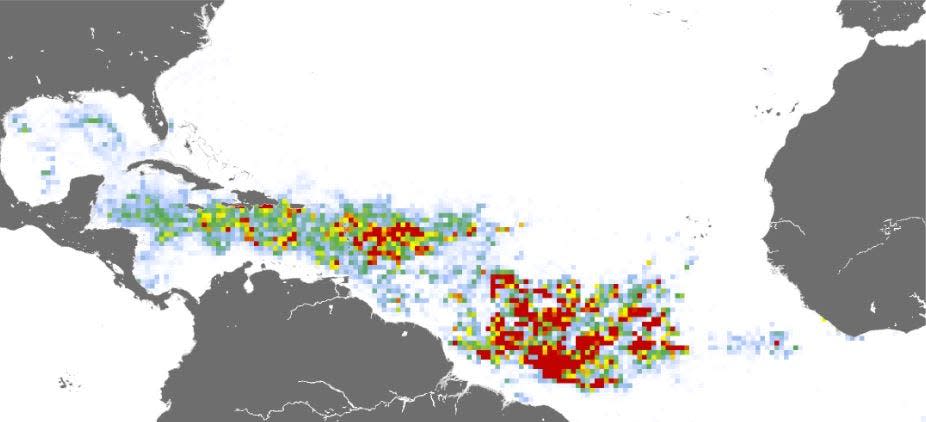Giant mats of seaweed lurk off Florida coast and have beached in spurts but will peak soon
A massive seaweed bloom expected to grow to record proportions before peaking in June is assaulting Florida beaches in hit or miss fashion depending on the way the wind blows.
An April sargassum forecast by the University of South Florida found mats of seaweed clogging the Caribbean Sea last month in amounts higher than previous Aprils, but the Gulf of Mexico's seaweed proliferation was below top levels.
The monthly sargassum report, which found 3 million tons of the pelagic flora in the Caribbean Sea, shows its growth spurt reaching its pinnacle in June before starting to dissipate.
USF oceanography professor Chuanmin Hu said sargassum in the Gulf of Mexico was in the high range at about the 75th percentile compared to years dating back to 2011.
Live look at beaches: Florida beach live webcams show surf, waves, sargassum seaweed conditions
What we know about the massive bloom: Sargassum aside, this seaweed is nothing to scoff at
It isn't pretty, but it's just seaweed: Sargassum bloom not all bad as it creates habitat, absorbs carbon. Here's what you should know
Where is the sargassum in Florida?
And while some South Florida beaches have been hit by seaweed incursions this spring, recent offshore winds have left many on the east coast free of the itchy plant, which can release a stinky hydrogen sulfide gas when it decays.
That doesn't mean beaches that are clean today will be that way tomorrow.
"You are going to have more in the coming weeks," Hu said about southeast Florida beaches. "There is a large amount in the lower Florida Keys and it will travel up the east coast."
From 2019: World's largest sargassum bloom, why it's probably here to stay
More: Change in giant sargassum blob offers 'glimmer of hope' but Florida could get hit in March

Once in the Gulf of Mexico, sargassum can get entrained in the loop current which runs through the Florida straits and becomes the north-flowing Gulf Stream current.
But how much sargassum lands on Florida beaches or along the immediate coast depends on winds. An easterly breeze, or onshore flow, can blow it toward the coast, causing it to stack up in piles that can be waist-high in some areas.
"Offshore of Palm Beach, there is no doubt that you will have a lot of sargassum in the coming weeks, but on the beach it could be a different story," Hu said.
How long will the sargassum seaweed last in Florida?

The natural growing season for sargassum is during spring months and the total amount of seaweed is expected to increase in May and then peak in June.
Hu said the past few months' growth of sargassum has not been a surprise, but researchers were taken aback in January, which was the second consecutive month that the amount of sargassum in the Atlantic doubled.
"We knew from there it would get bigger and bigger, and that's what's happened," Hu said.

Where did sargassum come from? What - or who - is most likely to blame for the bounty of sargassum that keeps coming?
Impact on beaches: Will Florida's beaches lose national rankings because of sargassum?
Worldwide mystery: What are those things the ocean’s been dumping on Palm Beach?
An upwelling of cool water that brings nutrients from the bottom of the ocean to feed the sargassum may be to blame for the winter growth, but Hu said that's just speculation at this point.
A total measurement of the Great Atlantic Sargassum belt, which stretches from the coast of Africa into the Gulf of Mexico, was difficult last month because of cloud cover, Hu said. Last year was a record-breaker for the total amount of sargassum, with it reaching a peak of 22 million tons in July. Hu said 2023 could be another major sargassum year, possibly surpassing 2022.
Is sargassum harmful?
Sargassum is a lifeline for fish nurseries, hungry migratory birds and sea turtle hatchlings seeking shelter in its buoyant saltwater blooms. But in mass quantities, it chokes life from canals, clogs boat propellers and is a killjoy at the beach, piling up several feet deep like a rotting bog emitting hydrogen sulfide as it decomposes.
While sargassum can help turtle hatchlings once they hit the water, high mounds on the beach are a barrier to them reaching it.
It's generally safe to swim in, but can turn the water an uninviting brown and be uncomfortable when it scratches against your skin.
Kimberly Miller is a veteran journalist for The Palm Beach Post, part of the USA Today Network of Florida. She covers real estate and how growth affects South Florida's environment. Subscribe to The Dirt for a weekly real estate roundup. If you have news tips, please send them to kmiller@pbpost.com. Help support our local journalism, subscribe today.
This article originally appeared on Palm Beach Post: Seaweed sargassum blob in Florida is growing: Updates on the bloom

